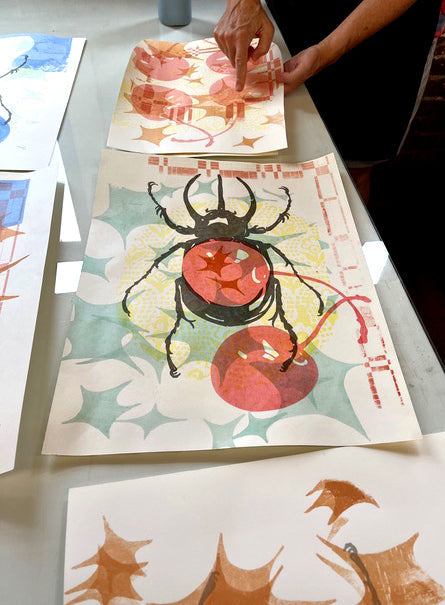Natural Screen Printing Ink with Natural Earth Pigments and Wheat Starch
Formulated by Ava Harper and Maggie Sullivan of Zea Mays Printmaking
We love to hear when our customers formulate a new natural art supply out of all earth and plant-based ingredients. The lovely artists and scientists at Zea Mays Printmaking are dedicated to innovations in safe and sustainable print-making techniques and they formulated this beautiful natural ink that we absolutely love.


Yields approx. 3 cups T-base
- 2 ¼ cup cold water
- ½ cup 5% white vinegar
- ⅝ cup white bread flour
- ⅛ cup corn starch dissolved in
- ¼ cup cold water
- 1/16 cup white sugar
- ¼ Tbsp. honey
- ½ Tbsp. pectin
- 1 tsp. Propylene glycol
- (optional: 1-2 drops clove/thyme essential oil)
Recipe:
1. Mix water, vinegar, and bread flour (sifted through tarlatan) in a medium pan with a whisk or mechanical frother until flour is fully dissolved.
2. Turn on low heat & continuously stir with a rubber spatula, frequently scraping sides/bottom of pan.
3. Once thickened to the texture of wet paint, add cornstarch mixture & keep stirring over heat. It will bubble but if it is boiling turn down the heat. 
5. Add honey, pectin, & sugar, stir
6. At this point, you are looking for a smooth, thick, but stir-able texture with all ingredients dissolved. If it is too thick, you can add a splash of water, if it is too thin, keep it on the heat! until fully combined.

7. Remove from heat & when cool enough to handle, mix in Propylene glycol, and then strain through your rinsed/rung out tarlatan. 

Mixing Dry Pigments into Wheat Starch T-Base
Using the T-Base you have prepared, you can create colored inks ready for printing using dry natural pigment powders. We prefer using Earth & Mineral Pigments from Natural Earth Paint. 
A small amount of this ink when mixed will go a long way, so plan to mix just what you need to use (Expect about a half a cup of ink to last you an edition of a good 20 prints!).
Using ¼ cup of T-Base, you can use this table and accompanying photo of our own tests to predict how dark your ink will turn out once mixed
We found that the best way to incorporate the pigments is to make the granules as small as possible, using a mortar & pestle, before mixing with the T-base. We also had luck with using a palette knife to crush the pigments while mixing. Test it out and find what works best for you!

Once you have decided how dark you want the ink to be, and the amount of dry pigment you are going to add, put a dollop of T-Base on a glass palette or table top, and add the pigment directly on top of it. Mix together with your palette knife, using lots of pressure to coat every granule of pigment in T Base.


Mix until the ink is a smooth, homogeneous texture with little to no pigment streaking. (this can take several minutes).
Print to your heart's content!!!
★Each pigment has its own unique ingredients and characteristics, some needing more to produce a bold color than others (for instance yellow requires approximately a x2 recipe) Experiment with these and see how they interact with each other! ☆Adding titanium white can increase opacity & brightness of the colors!
Examples of Prints made using Natural Screen Printing Ink: 

Zea Mays has conducted extensive research and tests using our Earth & Mineral Pigments - to see their in-depth tests, experiments, and images showing their results, please follow this link to receive the entire PDF for free!






